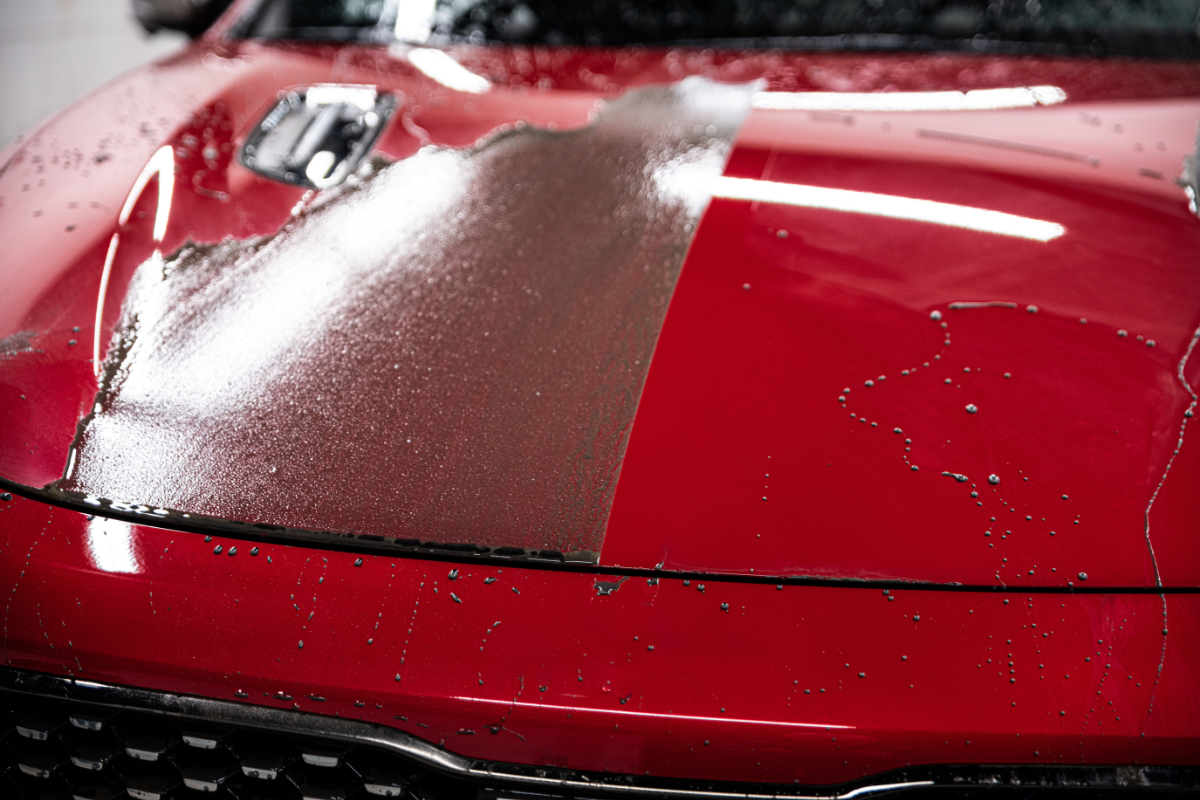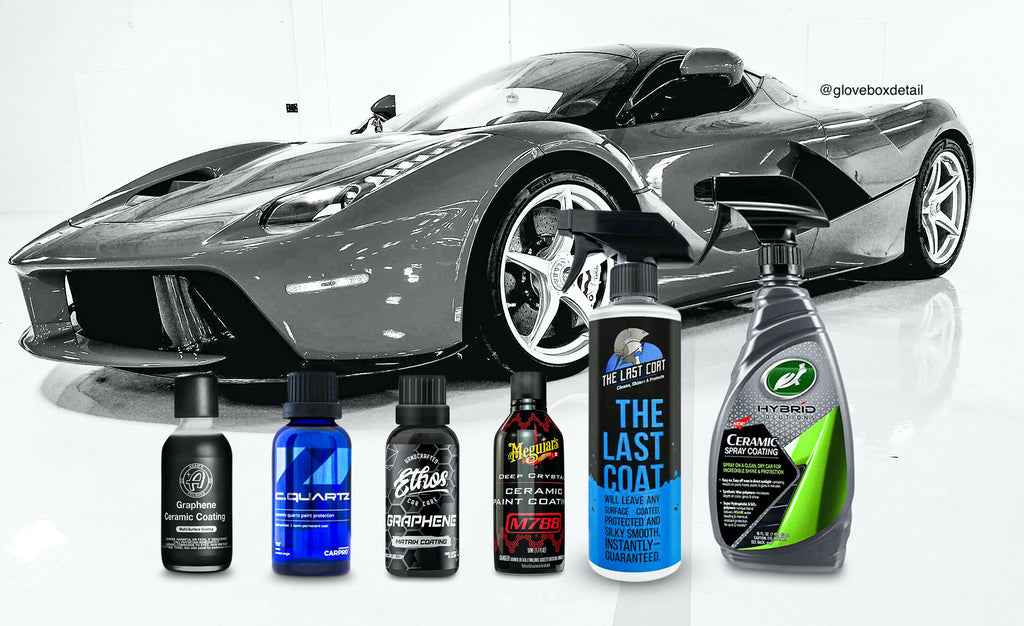Ceramic Pro: Raise Your Vehicle's Completed with Professional Layer
Ceramic Pro: Raise Your Vehicle's Completed with Professional Layer
Blog Article
The Scientific Research Behind Ceramic Coating: Just How It Boosts Your Vehicle's Visual and Longevity

Understanding Ceramic Coating Chemistry
The chemical composition of ceramic coatings plays a critical function in identifying their toughness and safety residential or commercial properties on lorry surface areas. Ceramic coverings are generally comprised of silicon dioxide (SiO2), which is a main part offering firmness and warmth resistance. Various other ingredients such as titanium dioxide, silicon carbide, and polysilazanes are commonly contributed to boost specific homes like UV resistance, adhesion, and hydrophobicity.
Silicon dioxide, likewise referred to as silica, creates a clear and strong layer on the car surface when applied properly. This layer acts as a guard, protecting the paint from ecological pollutants, UV rays, oxidation, and chemical discolorations. Titanium dioxide helps in blocking harmful UV rays that can cause paint fading and degeneration. Silicon carbide is understood for its abrasion resistance, making the ceramic coating tough and sturdy versus physical damages. Polysilazanes are made use of to improve the covering's adaptability and bond to the lorry's surface area, guaranteeing long-lasting protection. Understanding the chemistry behind ceramic finishes is important for both applicators and lorry owners to appreciate the worth and advantages these coatings provide in maintaining the visual appeal and durability of automobiles.
Boosted Gloss and Mirror-like End Up
Recognizing the chemical structure of ceramic finishings not just exposes their protective residential properties but also drops light on how they contribute to achieving an enhanced gloss and mirror-like finish on lorry surfaces - ceramic pro. Furthermore, the chemical structure of ceramic finishes enables them to create a strong bond with the car's paintwork, protecting against oxidation and keeping the clearness of the surface over time. The mix of loading residential properties, light representation, and resilient security makes ceramic coverings a popular option for those seeking a mirror-like and vibrant surface for their automobiles.

Influence On Paint Security and Long Life
Ceramic coatings for lorries substantially improve the longevity and security of the paintwork. By creating a chemically resistant layer on top of the lorry's clear coat, ceramic finishings act as a barrier against different ecological pollutants that can damage the paint over time.
In terms of durability, ceramic finishings use a long lasting remedy compared to traditional waxes or sealants. While waxes may last a couple of weeks to a couple of months, ceramic finishings can last years with proper maintenance. This extensive lifespan not just reduces the regularity of reapplications however additionally saves time and effort over time. In general, the safety residential or commercial properties of ceramic coverings contribute significantly to maintaining the lorry's paintwork and boosting its aesthetic appeal over an extensive duration.
Resistance to Impurities and Extreme Elements
With the safety guard given by ceramic finishings against various environmental contaminants and elements, lorries are able to maintain their immaculate look regardless of direct exposure to harsh problems. Ceramic coverings produce a solid barrier that drives away water, dust, dust, and various other common contaminants, avoiding them from bonding to the lorry's surface. This hydrophobic nature not just makes cleansing less complicated however additionally lowers the risk of water places and etching triggered by acidic impurities. Additionally, the chemical resistance of ceramic finishes helps protect the paint from bird droppings, insect splatter, tree sap, and other corrosive substances that can harm the surface in time.
Moreover, ceramic coatings provide UV defense, securing the vehicle's paint from the sun's damaging rays that can create fading and oxidation. This resistance to UV damage helps maintain the color intensity and shine of the paint for longer periods. By developing a durable and long-lasting obstacle, ceramic finishes make sure that the lorry's outside stays safeguarded against a wide variety of pollutants and harsh elements, protecting its visual allure and durability.
Application Strategies and Maintenance Tips
For optimum results when applying ceramic layers to lorries, utilizing proper methods and adhering to advised upkeep techniques are vital. The application procedure of ceramic finishing requires attention to detail and accuracy. Before using the ceramic layer, it is crucial to completely clean and sanitize the car's surface to make sure correct adhesion. This involves cleaning, claying, and potentially polishing the paint to develop a smooth canvas for the ceramic finishing to bond properly.
When using the ceramic covering, it is advised to work in small areas to guarantee try this even insurance coverage and to stop the product from drying too promptly. Making use of applicator pads or microfiber cloths, use the finish in a crisscross or up-and-down activity, depending upon the product's directions. After the finishing is used, allow it to treat for the specified time before rubbing off any deposit.
In regards to maintenance, routine cleaning with pH-neutral soaps and staying clear of unpleasant devices or harsh chemicals will aid preserve the ceramic finishing's integrity. Periodic inspections for any damages or endure the layer can also aid keep its Check This Out protective residential properties over time.

Final Thought
In final thought, ceramic finish improves a vehicle's aesthetic appeal and durability with its chemical structure, providing a glossy finish and securing the paint from ecological impurities. Its resistance to extreme components and convenience click over here of maintenance make it a prominent option for automobile owners wanting to protect the look of their lorries. On the whole, ceramic covering is a medically backed option for maintaining the appearance and durability of your lorry.
Recognizing the chemistry behind ceramic coverings is critical for both applicators and automobile owners to value the value and advantages these finishings provide in keeping the aesthetic appeal and long life of vehicles. (ceramic pro)
Understanding the chemical composition of ceramic coverings not just discloses their safety residential properties yet additionally sheds light on how they add to attaining an improved gloss and mirror-like finish on automobile surface areas. By forming a chemically resistant layer on top of the car's clear coat, ceramic finishes act as a barrier against numerous environmental pollutants that can harm the paint over time. Overall, the safety buildings of ceramic finishings add considerably to maintaining the vehicle's paintwork and enhancing its aesthetic appeal over an extended duration.
In conclusion, ceramic finish improves a lorry's aesthetic charm and durability with its chemical structure, offering a glossy finish and protecting the paint from environmental impurities.
Report this page